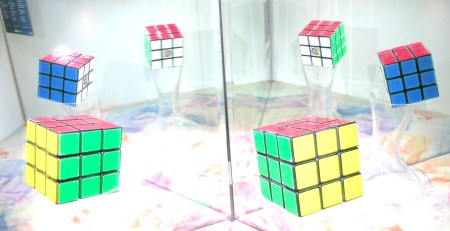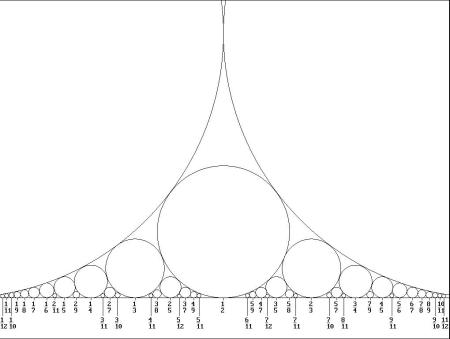OK, so here’s the latest update. I’ve been working on extending Fareyland into higher dimensions. I’ve now found a two-dimensional version of Fareyland, based on a unit triangle (i.e. an equilateral triangle of side 1). At each rational point on this triangle it is possible to place a sphere that touches the triangle at that point, with a radius of 1/2d, where d is the denominator of the square of the point’s distance from any corner of the triangle. (If different corners give different values of d for a particular point, then take their lowest common multiple.) Amazingly, none of these spheres overlap but they just touch their neighbors nicely. (This system is known as the Ford Spheres.)
This arrangement can also be generated by placing three spheres of unit diameter, one on each corner of the triangle, so that they touch each other, and then filling in the gaps between the spheres by placing smaller spheres between every three touching spheres. Keep doing this over and over and you eventually generate every sphere described above.
I haven’t worked out the details yet, but I’m fairly confident that this system can also be defined by partitioning the unit interval into three sections of rational length, or equivalently, by choosing three rational numbers that add to 1, which in turn is equivalent to choosing two rational numbers that add to not more than 1 (since they will define the third). So here we have a relationship between integers (OK, rational numbers, which are just pairs of integers) and a two-dimensional space. I’m still working out the details of the time dimension but it looks as though each sphere represents a “bubble” of spacetime. If this works, it will give me a system with two dimensions of space and one dimension of time, and I can start looking for the physical laws that govern this system. One interesting facet of this approach is that the space it defines does not expand, but instead becomes more detailed over time. (Of course, if you were inside the system, these phenomena would both look pretty much the same.) And of course, as we had in Fareyland, the edges wrap around so that each corner of the triangle is actually the same point. This gives a symmetrical space like the one I was speculating about here. (This particular space has a 6-way symmetry.)
A couple of notes here: I haven’t proven this mathematically yet, but I have verified it by computer for spheres down to a radius of 1/800 (I found 19,072 of them). And to clarify what I mean by “rational point”, I should add that this is a point which has rational coordinates in a system where the x- and y-axes are at 60° to each other, instead of the more usual 90°. (I may find it convenient to change the way that the coordinates are measured when I start to consider partitions.)
The most encouraging thing is that as I investigate this system, I expect it will become fairly clear how to extend it into three spatial dimensions. Stay posted for more details as I find them.



 Posted by P.Q.R. Theorist
Posted by P.Q.R. Theorist 
